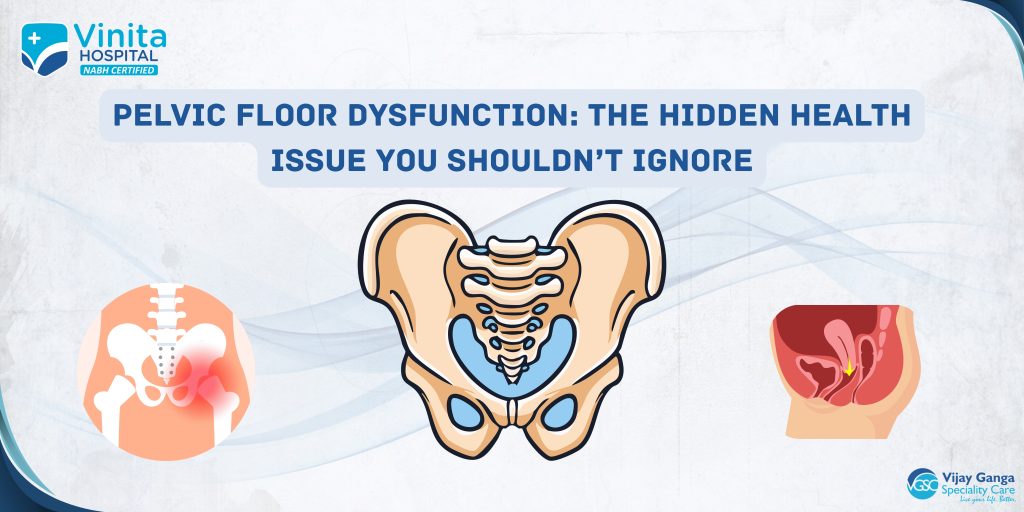Pelvic Floor Dysfunction: The Hidden Health Issue You Shouldn’t Ignore

Introduction
Have you ever laughed, sneezed, or lifted something heavy—only to experience a sudden urinary leakage? Or felt a constant heaviness in your lower abdomen? These could be signs of Pelvic Floor Dysfunction (PFD)—a condition millions silently struggle with. Surprisingly, when people Google health issues like “pelvic floor dysfunction symptoms,” “pelvic organ prolapse,” or “Kegel exercises,” they are really searching for answers to problems that physiotherapy can help solve.
This article will break down what PFD is, why it happens, and how Pelvic Floor physiotherapy can be life-changing—especially for women after childbirth, men post-surgery, and anyone facing bladder or bowel control issues.
What Is Pelvic Floor Dysfunction?
The pelvic floor is a group of muscles forming a hammock at the bottom of your pelvis. They support important organs like the bladder, uterus (in women), prostate (in men), and rectum. When these muscles are weak, tight, or not working in sync, you develop Pelvic Floor Dysfunction.
Common Pelvic Floor Dysfunction Symptoms
“Why am I leaking urine when I cough?” or “What is pelvic organ prolapse?” Here are some key red flags:
- Urinary incontinence → leakage while laughing, sneezing, lifting, or even resting.
- Pelvic organ prolapse → heaviness, bulging, or feeling that something is “falling out.”
- Constipation & straining → trouble emptying bowels, incomplete evacuation.
- Pelvic pain & painful intercourse → especially common in women.
- Frequent bathroom trips → urgent or uncontrolled urges to pee.
- Postpartum issues → weak muscles, recovery challenges after childbirth.
Who Is at Risk?
- Women after pregnancy and vaginal delivery (most searched: “postpartum pelvic floor recovery”).
- Men after prostate surgery.
- People with chronic constipation or obesity.
- Older adults (muscle tone naturally decreases with age).
- Fitness enthusiasts lifting heavy weights without proper posture.
- Post Menopausal.
- Early Hysterectomy.
- Multigravida – a woman who has had two or more pregnancies.
Treatment: How Pelvic Floor Physiotherapy Helps
The good news? PFD is treatable without surgery in most cases. Searches like “pelvic floor physiotherapy near me” are rising because more people are discovering the benefits.
- Kegel Exercises → Strengthen pelvic muscles (but must be done correctly).
- Biofeedback Therapy → Helps you see & train your pelvic muscle activity.
- NAC Techniques → For tight pelvic floor muscles control.
- Lifestyle Modification → Weight management, diet to prevent constipation, Avoid caffine at nights, Water balance (Avoid drinking water after 9 pm)
Easy Tips You Can Start Today
- Practice Kegel exercises: Squeeze, hold, release—like stopping urine mid-flow.
- Don’t strain in the toilet—use a footstool to improve posture.
- Stay active, but avoid heavy lifting without proper technique.
- Eat a fiber-rich diet & stay hydrated.
- If you notice symptoms, consult a Pelvic Floor Physiotherapist early.
Why Talking About It Matters
In India, pelvic floor health is often a taboo topic. But silence worsens the problem. By normalizing the conversation around urinary leakage, pelvic organ prolapse, and postpartum pelvic floor issues, we empower people to seek timely help.
Conclusion
Pelvic Floor Dysfunction is not just a “women’s issue”—it’s a health concern for all. And the earlier you act, the easier it is to manage. This Physiotherapy Week, let’s break the silence: if you or someone you know has these symptoms, encourage them to seek help. Because a stronger pelvic floor means a stronger, healthier life.
Read also Best Nephrologist in Chennai.
Read also Most Common Symptoms of PCOS
Check out Best Multispeciality Hospital in Chennai





